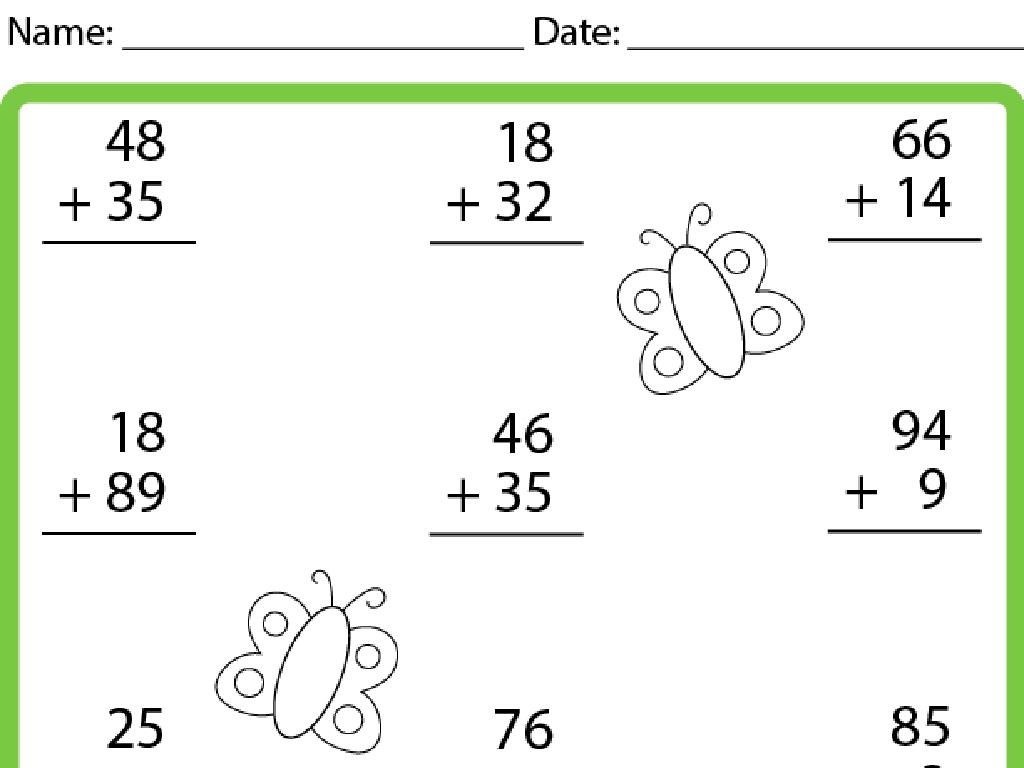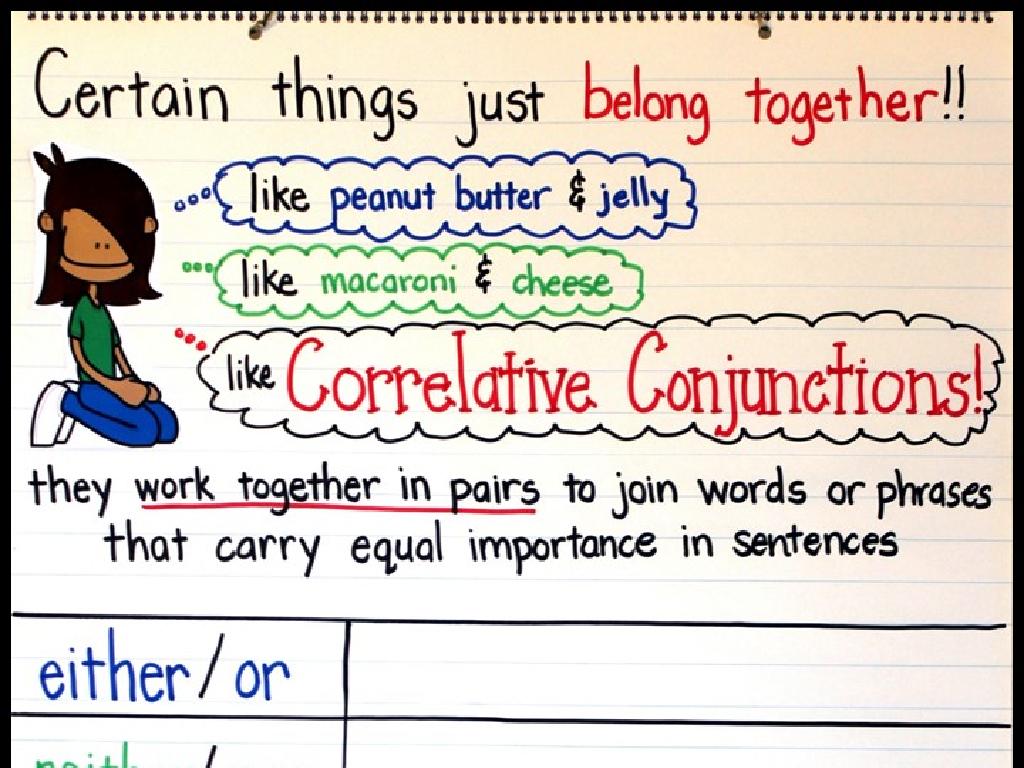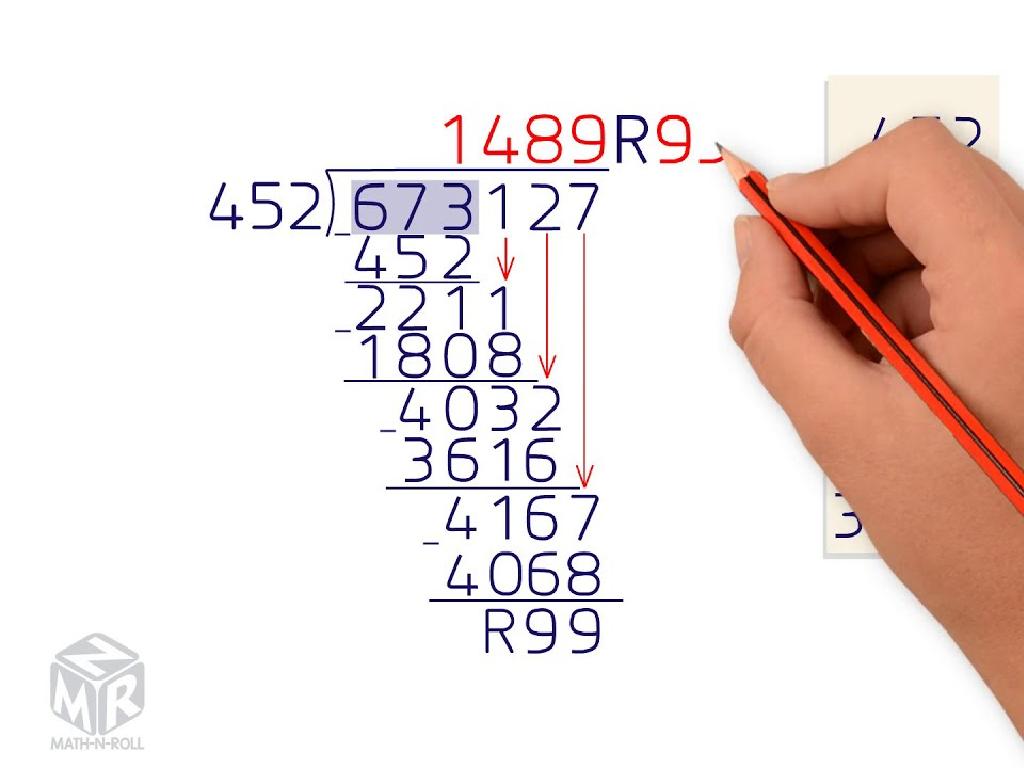Replace The Noun With A Personal Pronoun
Subject: Language arts
Grade: Fourth grade
Topic: Pronouns
Please LOG IN to download the presentation. Access is available to registered users only.
View More Content
Introduction to Pronouns
– What are pronouns?
– Words that take the place of nouns, like ‘he’, ‘she’, or ‘they’.
– Why use pronouns?
– To avoid repeating nouns and make sentences smoother.
– Pronouns in action
– ‘Sara is tall. She is a basketball player.’ ‘She’ replaces ‘Sara’.
– Practice replacing nouns
|
This slide introduces the concept of pronouns to fourth-grade students. Pronouns are essential parts of speech that replace nouns, making our sentences less repetitive and more fluid. Explain that pronouns can refer to people, places, things, or ideas without naming them directly. Use examples to show how pronouns function in sentences, such as replacing a person’s name with ‘he’, ‘she’, or ‘they’. Encourage students to think of pronouns as shortcuts in language that make our communication faster and more efficient. After explaining, engage the class with an activity where they replace nouns with appropriate pronouns in sample sentences.
Types of Pronouns
– Personal Pronouns: I, you, he, she, it, we, they
– Used to replace specific names of people or things
– Demonstrative Pronouns: this, that, these, those
– Point out specific items: ‘this’ for singular, ‘these’ for plural
– Interrogative Pronouns: who, what, where, when
– Ask questions about people or things: ‘who’ for people, ‘what’ for things
– Possessive Pronouns: my, your, his, her, its, our, their
– Show ownership: ‘my’ for the speaker, ‘your’ for the listener
|
This slide introduces students to the different types of pronouns and their functions. Personal pronouns replace the names of people or things. Demonstrative pronouns point to specific items and differ based on number (singular or plural). Interrogative pronouns are used to ask questions, with each having a specific use depending on the information required. Possessive pronouns indicate ownership or relation. Encourage students to practice using different pronouns in sentences and to understand how they can replace nouns to avoid repetition and make sentences clearer.
Personal Pronouns: Replacing Nouns
– Personal pronouns replace names
– Instead of ‘Sarah’, say ‘she’
– Subject pronouns: I, you, he, she, it, we, they
– ‘I’ for the one speaking, ‘you’ for the one listening
– Object pronouns: me, you, him, her, it, us, them
– ‘Me’ for the one receiving action, ‘him’ for a boy
– Practice using pronouns correctly
– Find sentences and swap nouns with pronouns
|
This slide introduces personal pronouns, which are used in place of people’s names to avoid repetition and simplify sentences. Subject pronouns are used when the person is the subject of the sentence, performing the action. Object pronouns are used when the person is receiving the action. Provide examples for each pronoun and encourage students to create sentences using both subject and object pronouns. For practice, students can work on exercises where they replace nouns with the correct personal pronouns, ensuring they understand the difference between subject and object pronouns.
Replacing Nouns with Personal Pronouns
– Identify nouns in sentences
– Find who or what the sentence is about
– Choose correct personal pronouns
– Use ‘he’, ‘she’, ‘it’, or ‘they’ to replace nouns
– Match pronoun to noun’s number
– Use ‘he’ or ‘she’ for singular, ‘they’ for plural nouns
– Match pronoun to noun’s gender
– Use ‘he’ for male, ‘she’ for female, ‘it’ for objects
|
This slide aims to teach students how to replace nouns with the appropriate personal pronouns while considering number and gender. Start by explaining how to identify nouns in a sentence, which are usually people, places, things, or ideas. Then, guide students on choosing the correct personal pronoun, emphasizing the importance of using ‘he’, ‘she’, ‘it’, or ‘they’ appropriately. Discuss the concept of agreement, ensuring that the pronoun matches the noun in both number (singular or plural) and gender (male, female, or neutral). Provide examples and practice sentences to reinforce the lesson. Encourage students to ask questions and create their own sentences for peer review.
Replacing Nouns with Pronouns
– Example: Using pronouns for Lisa
– ‘Lisa is my friend. She likes to read.’ replaces Lisa with She
– Let’s practice with pronouns!
– Interactive class examples
– We’ll replace nouns in sentences as a group
– Why pronouns are useful
– Pronouns make sentences shorter and avoid repetition
|
This slide is aimed at teaching students how to replace nouns with the appropriate personal pronouns to avoid repetition and make sentences sound better. Start with the example provided, explaining how ‘Lisa’ is replaced by ‘she’ to prevent saying Lisa’s name over and over. Then, engage the class with interactive examples where students can volunteer to replace nouns with pronouns in sentences you provide. Emphasize the importance of pronouns in making our speech and writing more fluent and less repetitive. Encourage students to think of pronouns as a way to simplify and connect their ideas more clearly.
Class Activity: Pronoun Hunt
– Find nouns in a favorite book
– Replace nouns with pronouns
– Use ‘he’, ‘she’, ‘it’, ‘they’ instead of names and objects
– Share new sentences with the class
– Understand pronoun usage
– Learn how pronouns can take the place of nouns
|
This activity is designed to help students practice identifying nouns and replacing them with appropriate pronouns, enhancing their understanding of pronoun usage in sentences. Provide examples of how a noun can be replaced by a pronoun, such as changing ‘The cat chased the mouse’ to ‘It chased the mouse.’ Encourage students to choose sentences from books they enjoy and to think carefully about which pronouns make sense in place of the nouns. After they have written their new sentences, ask them to share with the class to foster a collaborative learning environment. This will also allow for discussion and correction of any misunderstandings. For students who finish early, challenge them to find sentences that require different pronoun cases, such as subject, object, or possessive pronouns.
Wrapping Up: Pronouns & Homework
– Recap on pronouns usage
– Why pronouns matter
– Pronouns make sentences less repetitive and more interesting.
– Homework: 10 sentences
– Choose any storybook for this exercise.
– Replace nouns with pronouns
– Find nouns in sentences and change them to he, she, it, they, etc.
|
As we conclude today’s lesson, remind the students about the role of pronouns in making our writing and speech flow better by avoiding repetition. Emphasize the importance of pronouns in creating variety and maintaining interest in our communication. For homework, students should practice this skill by taking sentences from any storybook and substituting the nouns with appropriate pronouns. This will help reinforce their understanding of pronouns and how they are used in context. Encourage them to share their sentences in the next class for a collaborative learning experience.






